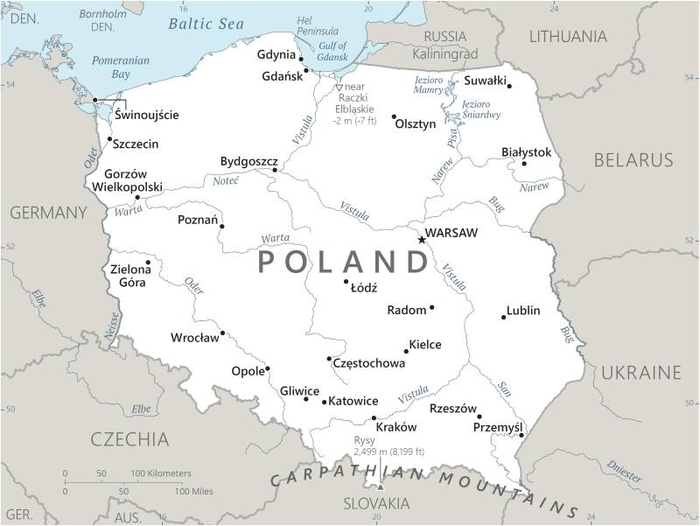102 Poland

Two equal horizontal bands of white (top) and red. Colors derive from the Polish emblem – a white eagle on a red field.
Flag courtesy of the CIA World Factbook

Map courtesy of the CIA World Factbook

Memorial monument at the Plaszow forced labor and concentration camp south of Krakow. Most of the prisoners at the World War II camp – which was operated by the occupying Nazi German Army between October 1942 and January 1945 – were Polish Jews. While the camp was not an extermination site, some 8 to 12,000 people are estimated to have been murdered at Plaszow.
Photo courtesy of the CIA World Factbook
Government
According to Britannica, the constitution of Poland’s postwar socialist state, the Polish People’s Republic, took effect in 1952 but was amended numerous times, most significantly in early 1989, when constitutional reforms worked out between the government and Solidarity were passed by the Sejm (legislature). Among the changes were the replacement of the Council of State by the office of president (a position that had been eliminated in 1952) and the reinstatement of the Senate, which had been abolished in 1946 in an allegedly rigged national referendum. The existing Sejm, with 460 members, became the lower house of the new legislature, and the Senate, or the upper house, was assigned 100 members. Additional reforms passed later in 1989 by the legislature included the guarantee of free formation of political parties and the return of the state’s official name to the Republic of Poland.
The new constitution of 1997, which replaced a 1992 interim constitution, was adopted in April by the National Assembly (Zgromadzenie Narodowe; as the Sejm and the Senate are referred to when they meet in a joint session to debate constitutional issues), approved in a national referendum in May, and promulgated in October. The constitution confirmed the mixed presidential-parliamentary form of government that had been established during the period 1989–92. Under its provisions the president is directly elected to not more than two five-year terms. The president serves as commander in chief of the armed forces, has the power (albeit restricted) to declare martial law or a state of emergency, and can veto an act of the Sejm (which in turn can override that veto with a three-fifths majority vote).
The president nominates the prime minister and, on the prime minister’s recommendation, the cabinet, subject to the Sejm’s approval, but the president cannot dismiss the government. Deputies in the Sejm and senators are popularly elected to four-year terms. Laws must be adopted by both houses. The Senate has the right to amend or reject a law passed by the Sejm. The Sejm may override the Senate’s decision with a majority vote. The Sejm appoints the members of the Constitutional Tribunal, the commissioner for civil rights protection (the ombudsman), the chairman of the Supreme Chamber of Control (the state audit commission), and the president of the Bank of Poland. The main executive power is vested in the prime minister and the Council of Ministers, who are responsible to the Sejm. The government can be terminated by the Sejm only by a constructive vote of no confidence. The prime minister has a role comparable to that of a chancellor in the German political system.
Local government in Poland is organized on three levels. The largest units, at the regional level, are the województwa (provinces), which were consolidated and reduced in number from 49 to 16 in 1999. At the next level are some 300 powiaty (counties or districts), followed by about 2,500 gminy (towns and rural communes). The last are the fundamental territorial units within Poland. The status of the capital city of Warsaw is regulated by a special legislation. Both powiaty and gminy are governed by councils, elected to four-year terms. These councils in turn elect the heads of local administration. The representatives to the sejmiki wojewódzkie (provincial legislature) also are elected to four-year terms. The head of provincial administration, the wojewoda, is nominated by the prime minister.
Local government in Poland is organized on three levels. The largest units, at the regional level, are the województwa (provinces), which were consolidated and reduced in number from 49 to 16 in 1999. At the next level are some 300 powiaty (counties or districts), followed by about 2,500 gminy (towns and rural communes). The last are the fundamental territorial units within Poland. The status of the capital city of Warsaw is regulated by a special legislation. Both powiaty and gminy are governed by councils, elected to four-year terms. These councils in turn elect the heads of local administration. The representatives to the sejmiki wojewódzkie (provincial legislature) also are elected to four-year terms. The head of provincial administration, the wojewoda, is nominated by the prime minister.
Civil Aviation Authority (CAA)
The Civil Aviation Authority has a mission to act for the safety and sustainable development of civil aviation in Poland.
Airspace
SkyVector – Google Maps – ADS-B Exchange
ICAO countries publish an Aeronautical Information Publication (AIP). This document is divided into three parts: General (GEN), En Route (ENR) and Aerodromes (AD). ENR 1.4 details the types of airspace classes they chose to adopt from classes A through G.
PANSA
AIS is a special Polish Air Navigation Services Agency’s authority, designated to ensure aeronautical information service in Poland.
Standards and Recommended Practices for aeronautical information services were first adopted by the Council on 15 May 1953, pursuant to the provisions of Article 37 of the Convention on International Civil Aviation, and were designated as Annex 15 to the Convention.
Drone Regulations
Check airspace availability (by entering parameters of the planned flight) via DroneRadar application or PANSA website.
Advanced Air Mobility (AAM) Regulations & Policies
IFAR – International Forum for Aviation Research – AAM
Bilateral agreements facilitate the reciprocal airworthiness certification of civil aeronautical products imported/exported between two signatory countries. A Bilateral Airworthiness Agreement (BAA) or Bilateral Aviation Safety Agreement (BASA) with Implementation Procedures for Airworthiness (IPA) provides for airworthiness technical cooperation between the FAA and its counterpart civil aviation authorities.
Reciprocal acceptance of aviation safety-related approvals and services with the European Union Aviation Safety Agency (EASA) and Member States of the European Union are primarily governed by the U.S. – European Union Safety Agreement.
Advanced Air Mobility (AAM) News
2025
Video courtesy of Advanced Air Mobility Institute from the July 2025 Global AAM Forum.
2025
Video courtesy of Advanced Air Mobility Institute from the January 2025 Global AAM Forum. Complete session for Day 1 of this Forum is available on the Advanced Air Mobility Institute YouTube Channel
2021 – Poland begins first flights over cities as part of SESAR Uspace4UAM research
2021 – European UAM Project Gets Underway in Poland
Short Essay Questions
Scenario-Based Question
You have been hired by a Drone Startup Company. Your boss has immediately assigned this job to you.
They need you to prepare a one-page memo detailing the legalities of using a drone to film the monument in Krakow, pictured above.
They need you to mention any national laws and local ordinances.
They specifically want to know what airspace (insert pictures) you will be operating in and whether or not you need an airspace authorization.
Does it matter whether or not you are a citizen of the country?
Lastly, there is a bonus for you if, as you scroll through this chapter, you find any typos or broken links!
Short Essay Questions
- What are the drone categories?
- How is registration addressed?
- How is remote ID addressed?
- What are the model aircraft rules?
- What are the commercial drone rules?
- Are there waivers or exemptions to the rules? If so, for what?
- Would you share a link to an interactive airspace map?
- How is BVLOS addressed?
- How can you fly drones at night?
- How can you fly drones over people?
- Where do you find drone NOTAMs?
- What are the rules for drone maintenance?
- What are the rules for an SMS program?
- What are some unique rules not mentioned above?
- What are the C-UAS rules?
- What are the AAM rules?

